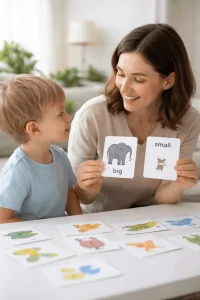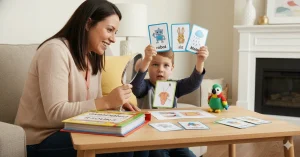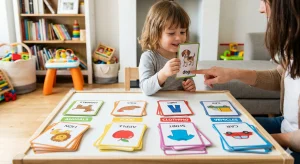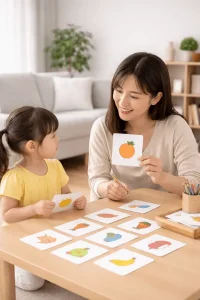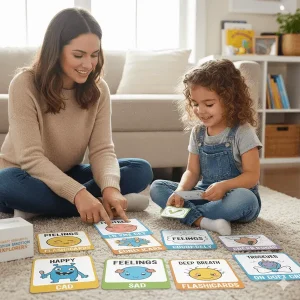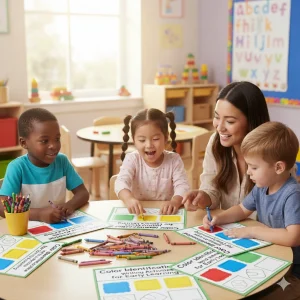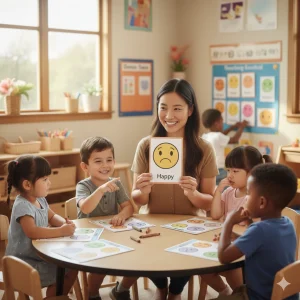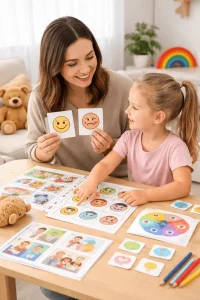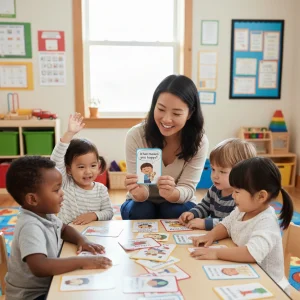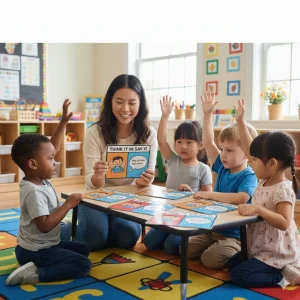14 Effective Cognitive Behavioral Therapy Activities to Help Kids
By Wellness Hub
Last Updated: August 28, 2024
Cognitive Behavioral Therapy, or CBT, is a practical and focused approach that helps children understand how their thoughts, feelings, and behaviors are connected. Imagine your mind as a garden: what you plant and nurture—whether it’s positive or negative—grows and affects everything else around it. Cognitive Behavioral Therapy works in much the same way. It teaches kids to recognize negative thoughts that might be sprouting and how these thoughts influence their feelings and actions. Once they understand this, they can learn to replace those negative thoughts with healthier, more positive ones.
One of the reasons CBT is so effective for children is that it’s structured and goal-oriented. This means that rather than just talking about problems, each session has a clear focus on specific issues, with the goal of finding practical solutions. Whether a child is struggling with anxiety, depression, anger, or other challenges, CBT is designed to address these issues quickly and efficiently. Typically, CBT doesn’t last forever—it’s a short-term therapy that can bring about lasting changes in just a few sessions. This makes it an ideal option for kids who need help with immediate problems.
Also Read: What is Cognitive Behavioral Therapy – A Complete Guide
Benefits of CBT for Children
Cognitive Behavioral Therapy (CBT) offers children a powerful way to navigate life’s challenges by teaching them how to change their thought patterns. For many kids, learning to manage emotions like anxiety, anger, or sadness can feel overwhelming. This is where CBT steps in, providing them with practical coping strategies they can use daily. By focusing on how thoughts influence feelings and behaviors, CBT helps children develop healthier thinking habits that lead to more positive outcomes.
One of the key benefits of CBT is its ability to reduce negative thinking. Children are often unaware of how certain thoughts can trigger feelings of fear, frustration, or hopelessness. CBT helps them identify these negative thought patterns and replace them with more constructive ones. Over time, this shift can significantly improve a child’s mental well-being, leading to greater confidence, resilience, and emotional balance.
Another advantage of CBT is its flexibility. Every child is unique, and so are their challenges. CBT can be tailored to meet the specific needs of each child, whether they’re dealing with anxiety, depression, ADHD, or any other issue. This personalized approach ensures that the therapy is relevant and effective, making it easier for children to engage with the process and see real results.
Read more: Understanding Behavioral Therapy: A Simple Guide for Parents
14 Effective CBT Activities to Help Kids Cope
Cognitive Behavioral Therapy activities are not just therapeutic—they can also be fun and engaging, making it easier for children to learn and practice coping strategies. Below are 14 effective CBT activities that can help kids manage their emotions, challenge negative thoughts, and build resilience.
1) DIY Stress Balls
Creating and using stress balls is a fantastic way for children to manage anxiety and stress. The process of making a stress ball is both creative and interactive, which helps children feel more involved. Once made, these stress balls can be squeezed during moments of tension, providing an immediate and satisfying outlet for stress relief. Plus, it’s a great way to start conversations about emotions in a relaxed setting.
2) Feelings Thermometer
A feelings thermometer is a visual tool that helps children identify and understand the intensity of their emotions. By assigning different colors or numbers to various levels of feelings, children can better gauge their emotional state and learn how to regulate their responses. This activity encourages self-awareness and teaches kids that emotions can vary in intensity, helping them to manage their reactions more effectively.
3) Calm Down Jars
Calm down jars are simple yet powerful tools for soothing anxiety and promoting focus. When shaken, the swirling glitter inside the jar captivates a child’s attention, giving them something to focus on as they work through their emotions. As the glitter settles, so too does their heart rate and breathing, allowing them to regain control over their emotions. This activity is particularly effective for calming children who feel overwhelmed.
4) Mindful Breathing Exercises
Teaching children how to control their breathing during stressful moments is a key component of CBT. The Bubble Blowing Technique is ideal for younger kids, as it turns mindful breathing into a playful activity. For older kids, the Hissing Breath technique involves inhaling deeply through the nose and exhaling slowly through the mouth with a long “hiss.” Both methods help children slow down their breathing, which naturally reduces stress and anxiety.
5) Challenging Negative Thinking
Negative thoughts can greatly impact a child’s mood and behavior. CBT focuses on helping children identify these negative thoughts and replace them with positive ones. For example, if a child feels like they’re “not good enough,” they can learn to challenge this belief by listing their strengths or past successes. Over time, this practice can help shift their mindset toward more positive and constructive thinking.
6) Don’t Go Bananas! Game
The “Don’t Go Bananas!” game is a great way to help children manage strong emotions like anger, worry, and fear. This card game encourages kids to identify their triggers and think about how they react to them. Through playful interaction, children learn to recognize and modify their emotional responses, making it easier for them to stay calm and think clearly in challenging situations.
7) Mad Dragon Game
Mad Dragon is a game designed to teach children that they have choices in how they express anger. Through this interactive game, children learn about the different ways anger can manifest and explore healthier alternatives for managing their feelings. It’s a practical way to help kids understand that while anger is natural, how they choose to express it is within their control.
8) Reading Together
Books can be a wonderful way to reinforce CBT principles in children. Titles “like Wilma Jean the Worry Machine and I Like Myself!” use engaging stories to teach children how to cope with anxiety and boost self-esteem. Reading together not only strengthens the parent-child bond but also offers a gentle introduction to complex emotional topics in a way that’s easy for kids to understand.
9) Cognitive Behavioral Therapy Worksheets
CBT worksheets are useful tools that allow children to practice the skills they’ve learned during therapy. These worksheets often include activities like identifying negative thoughts, setting goals, and tracking emotions. By completing these worksheets, children can reinforce their understanding of CBT concepts and build confidence in their ability to manage their thoughts and feelings.
10) Role-Playing Scenarios
Role-playing is a valuable technique for helping children practice responses to challenging situations. By acting out different scenarios, kids can explore how they might handle conflicts, social pressures, or difficult emotions. This hands-on approach helps children feel more prepared and confident when they encounter similar situations in real life.
11) Creating a Safe Space
A designated “safe space” at home can provide children with a comforting place to retreat when they need to calm down. This space could include calming items like soft pillows, favorite books, or sensory toys. Having a go-to spot where they feel secure helps children learn to self-soothe and manage their emotions independently.
12) Positive Affirmation Activities
Positive affirmations are powerful statements that children can use to build self-esteem and confidence. Activities that involve creating and repeating affirmations help children focus on their strengths and abilities. For example, a child might repeat, “I am brave” or “I can do hard things” to reinforce positive thinking and build resilience against negative thoughts.
13) Problem-Solving Tasks
Problem-solving tasks encourage children to think critically about how they can overcome challenges. These tasks might involve brainstorming solutions to a hypothetical problem or working through real-life situations they’ve encountered. By practicing problem-solving, children develop a sense of agency and learn that they can find solutions to difficult situations.
14) Journaling
Journaling is a reflective activity that helps children process their thoughts and emotions. By writing down their feelings, children can gain clarity and perspective on their experiences. Journaling also serves as a safe outlet for expressing emotions that they might find difficult to talk about. Over time, it can become a valuable tool for self-discovery and emotional growth.
| Cognitive Behavioral Therapy Activities | Examples |
|---|---|
| 1. DIY Stress Balls | Make stress balls using balloons filled with flour or rice to help kids squeeze out stress. |
| 2. Feelings Thermometer | Create a color-coded thermometer that shows different levels of emotions from calm to angry. |
| 3. Calm Down Jars | Fill a jar with glitter and water; kids shake it to watch the glitter settle as they calm down. |
| 4. Mindful Breathing Exercises | Use the Bubble Blowing Technique for younger kids or Hissing Breath for older kids to manage stress. |
| 5. Challenging Negative Thinking | Teach kids to replace ‘I can’t do this’ with ‘I’ll try my best’ when facing challenges. |
| 6. Don’t Go Bananas! Game | Play a card game that helps kids recognize and manage emotions like anger and worry. |
| 7. Mad Dragon Game | A game where kids learn to control how they express anger by choosing constructive actions. |
| 8. Reading Together | Read books like Wilma Jean the Worry Machine to teach kids how to handle anxiety. |
| 9. Cognitive Behavioral Therapy Worksheets | Use worksheets to practice identifying and replacing negative thoughts with positive ones. |
| 10. Role-Playing Scenarios | Act out scenarios where kids practice responding to difficult situations, like sharing toys. |
| 11. Creating a Safe Space | Set up a cozy corner with soft pillows and favorite toys for kids to retreat to when stressed. |
| 12. Positive Affirmation Activities | Encourage kids to repeat phrases like ‘I am brave’ to build self-esteem and confidence. |
| 13. Problem-Solving Tasks | Present a problem and have kids brainstorm solutions, like what to do if they feel left out. |
| 14. Journaling | Have kids write or draw about their day to help process emotions and thoughts. |
Tips for Implementing Cognitive Behavioral Therapy Activities
Successfully integrating Cognitive Behavioral Therapy activities into your child’s daily routine doesn’t have to be challenging. With the right approach, these activities can become a natural part of your child’s life, helping them to manage their emotions and develop positive coping strategies. Here are some practical tips for parents and therapists to make the most out of these activities.
1. Start Small and Build Gradually
When introducing CBT activities, start with one or two simple tasks and gradually add more as your child becomes comfortable. For example, you might begin with something fun like creating a DIY stress ball or practicing mindful breathing. Once your child gets the hang of these, you can introduce more structured activities like challenging negative thoughts or role-playing scenarios. By building up gradually, you avoid overwhelming your child and help them develop confidence in their new skills.
2. Make It a Part of Daily Life
The key to making CBT activities effective is consistency. Try to weave these activities into your child’s everyday routine. For instance, use the feelings thermometer during daily check-ins or practice mindful breathing before bedtime. The more integrated these activities are in daily life, the more natural they’ll feel for your child. Remember, consistency helps reinforce the new behaviors and thought patterns you’re trying to establish.
3. Be Patient and Positive
Change takes time, especially when it comes to shifting thought patterns and behaviors. It’s important to be patient and celebrate small victories along the way. Positive reinforcement can be a powerful motivator. Praise your child when they use a CBT technique on their own or when they show improvement in managing their emotions. This not only boosts their confidence but also encourages them to keep using these strategies.
4. Tailor Activities to Your Child’s Needs
Every child is unique, and what works for one may not work for another. Pay attention to what resonates with your child and tailor the activities to suit their preferences and needs. If your child enjoys creative tasks, focus on activities like making calm down jars or drawing their feelings. For children who prefer structure, worksheets and problem-solving tasks might be more engaging. The goal is to make CBT enjoyable and relevant to your child’s world.
5. Collaborate with Your Child
Involve your child in the process by letting them choose some of the activities or decide when to do them. When children feel like they have a say, they’re more likely to engage with the activities and take ownership of their emotional well-being. This collaborative approach can also strengthen the parent-child or therapist-child relationship, making the process more effective.
6. Seek Support When Needed
While these tips can help you implement CBT activities at home, it’s important to know when to seek additional support. If your child is struggling to engage with the activities or if their challenges seem overwhelming, reaching out to a professional can make a big difference. For tailored guidance and resources, consider exploring options at Wellness Hub, where you can find expert advice and support suited to your child’s unique needs.
Conclusion
Incorporating Cognitive Behavioral Therapy (CBT) activities into your child’s daily routine can make a big difference in how they handle their emotions. These activities, like making stress balls or practicing mindful breathing, give children practical tools to manage stress, challenge negative thoughts, and build resilience. By using these activities regularly, children learn that they have control over their thoughts and actions, which helps them feel more confident and improves their overall well-being.
With the right support and consistent practice, children can develop strong coping skills that will benefit them throughout their lives. While the process may take time and patience, the positive changes are worth it. If you’re looking for extra guidance or resources, Wellness Hub offers personalized therapy options and expert advice to help your child succeed. Remember, every small step forward is a victory, and with continued effort, your child can learn to face life’s challenges with confidence and strength.
Frequently Asked Questions:
1. What is Cognitive Behavioral Therapy (CBT) and how does it help children?
Cognitive Behavioral Therapy (CBT) is a structured form of therapy that helps children understand the connection between their thoughts, feelings, and behaviors. By recognizing and changing negative thought patterns, CBT helps kids manage emotions like anxiety, anger, and sadness more effectively.
2. How can CBT activities benefit my child?
CBT activities provide children with practical tools to manage stress, challenge negative thoughts, and build resilience. These activities help improve a child’s emotional regulation, boost confidence, and enhance their overall mental well-being.
3. What are some simple CBT activities I can do with my child at home?
There are many easy CBT activities you can try at home, such as making stress balls, creating a feelings thermometer, practicing mindful breathing, and using positive affirmations. These activities are both fun and effective in helping children cope with their emotions.
4. How often should we do CBT activities?
Consistency is key when it comes to CBT. Try to incorporate these activities into your child’s daily routine. Regular practice helps reinforce the new skills they are learning and makes these activities a natural part of their day.
5. Can CBT activities be tailored to my child’s specific needs?
Yes, CBT activities can be adapted to fit your child’s unique needs and preferences. Whether your child enjoys creative tasks, structured exercises, or interactive games, there are CBT activities that can be customized to suit their personality and challenges.
6. How can I support my child in using CBT techniques?
Encourage your child to practice CBT activities regularly, praise their efforts, and be patient with their progress. Positive reinforcement and consistency are important. If needed, seek additional guidance from professionals to ensure your child gets the most benefit from CBT.
7. Where can I find more resources or professional support for my child?
For more resources and personalized support, consider exploring Wellness Hub. They offer a variety of therapy options and expert advice to help your child develop strong coping skills and improve their mental health.
8. Are CBT activities suitable for children of all ages?
Yes, CBT activities can be adapted for children of different ages. While younger children might enjoy activities like the Bubble Blowing Technique or calm down jars, older children may benefit more from role-playing scenarios or journaling. The key is to choose activities that match your child’s developmental stage and interests.
9. How long does it take to see results from CBT activities?
The time it takes to see results can vary depending on the child and the consistency of the practice. Some children may start to show improvements within a few weeks, while others may take longer. The important thing is to remain patient and keep encouraging regular use of the activities.
10. Can CBT activities be used alongside other forms of therapy?
Absolutely. CBT activities can complement other forms of therapy, such as play therapy or family counseling. They provide additional tools that can reinforce the progress made in other therapeutic settings, helping children develop a well-rounded approach to managing their mental health.
About Author:
Lasya Vooturi,
Clinical Psychologist (A) & Behavioral Therapist
Lasya holds a Professional Diploma in Clinical Psychology from Amity University, where she deepened her understanding of psychological principles from March 2023 to March 2024. With over a year of dedicated experience as a Behavioral Therapist, Lasya has honed her skills in applying effective therapy techniques tailored to individual needs. Fluent in Telugu, Hindi, and English, she is adept at connecting with a diverse range of clients, ensuring comprehensive communication and understanding. Lasya’s approach is grounded in empathy and scientific rigor, making her a trusted ally in navigating mental health challenges.
Book your Free Consultation Today
Parent/Caregiver Info:
Client’s Details:
* Error Message
